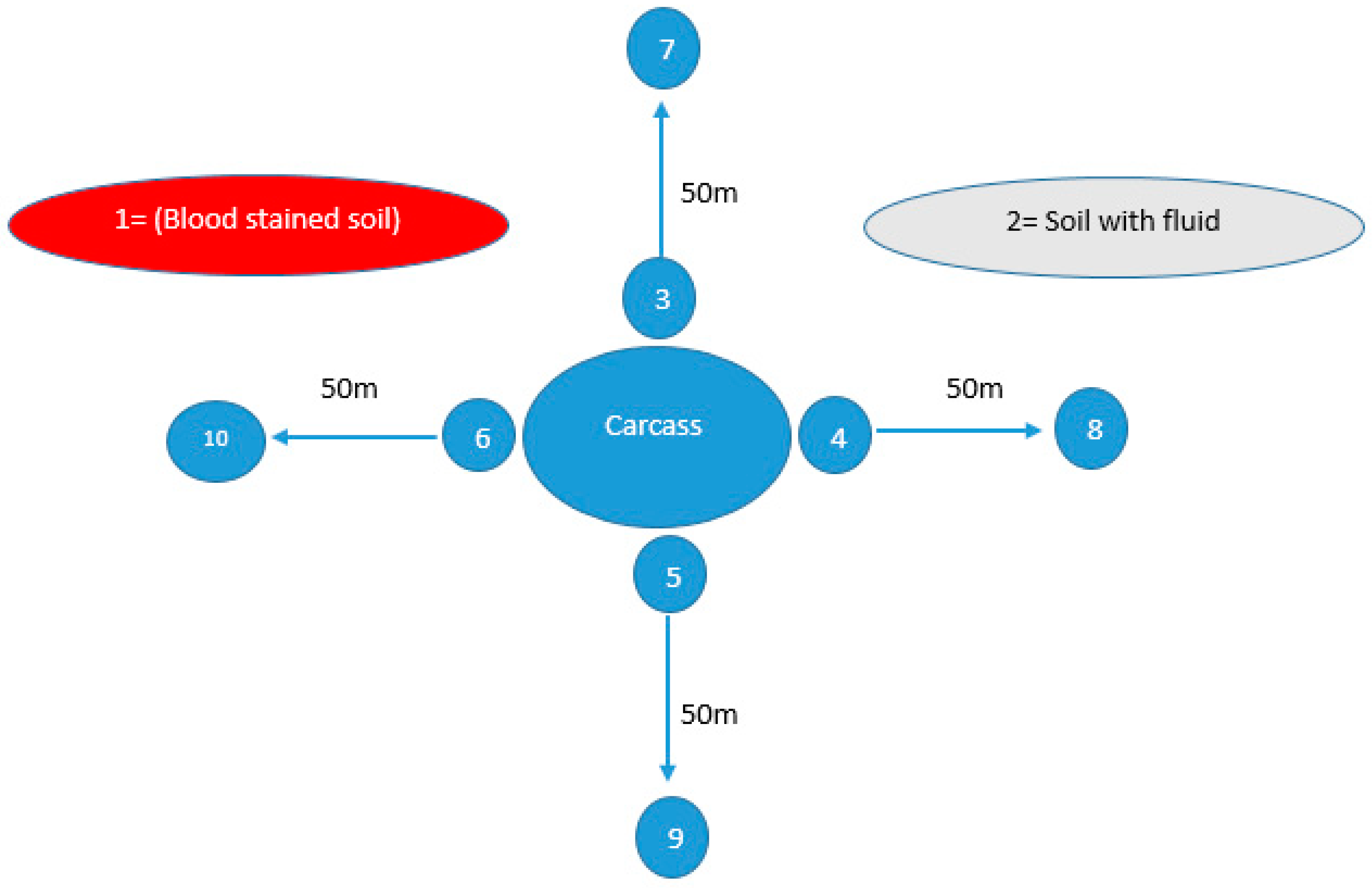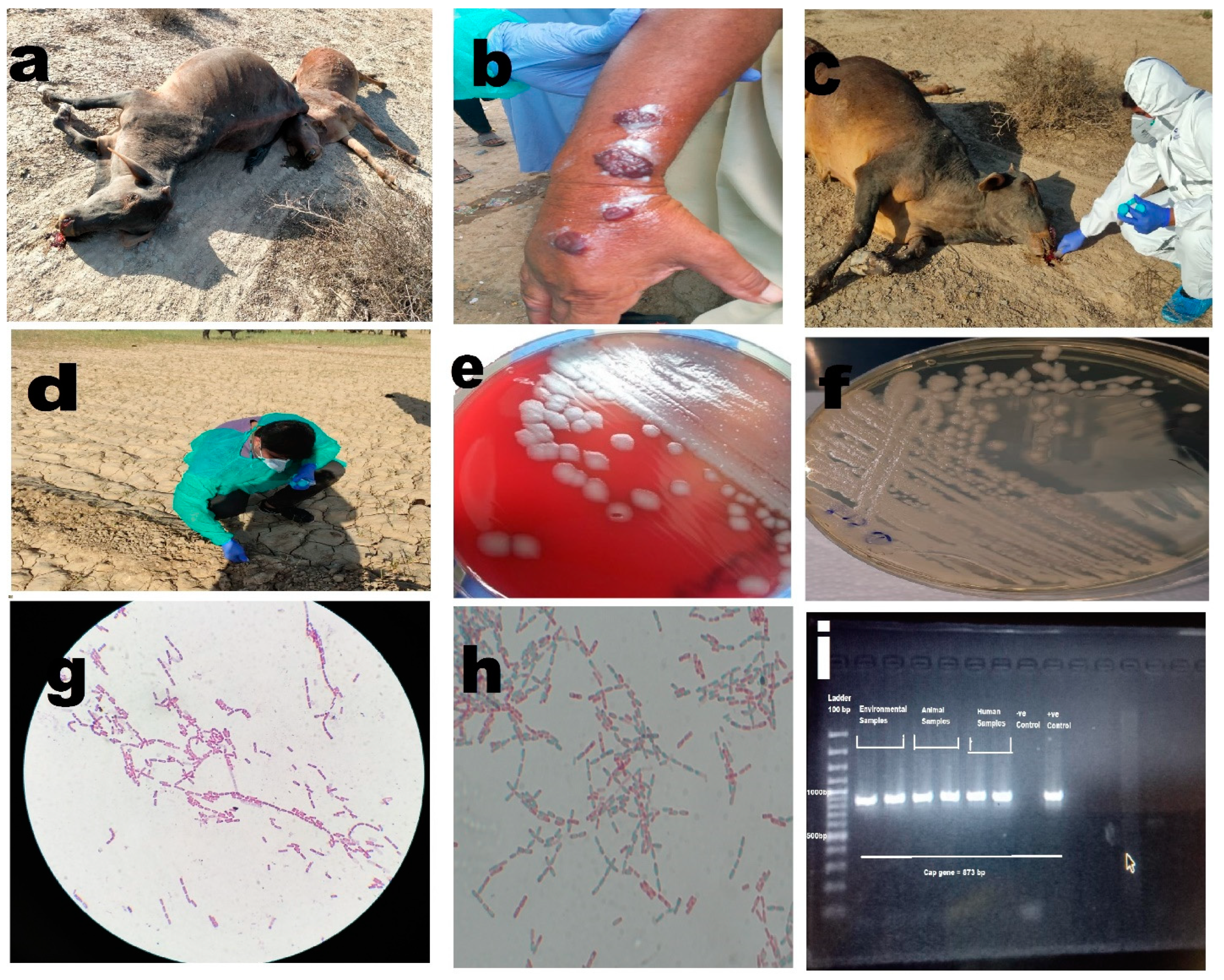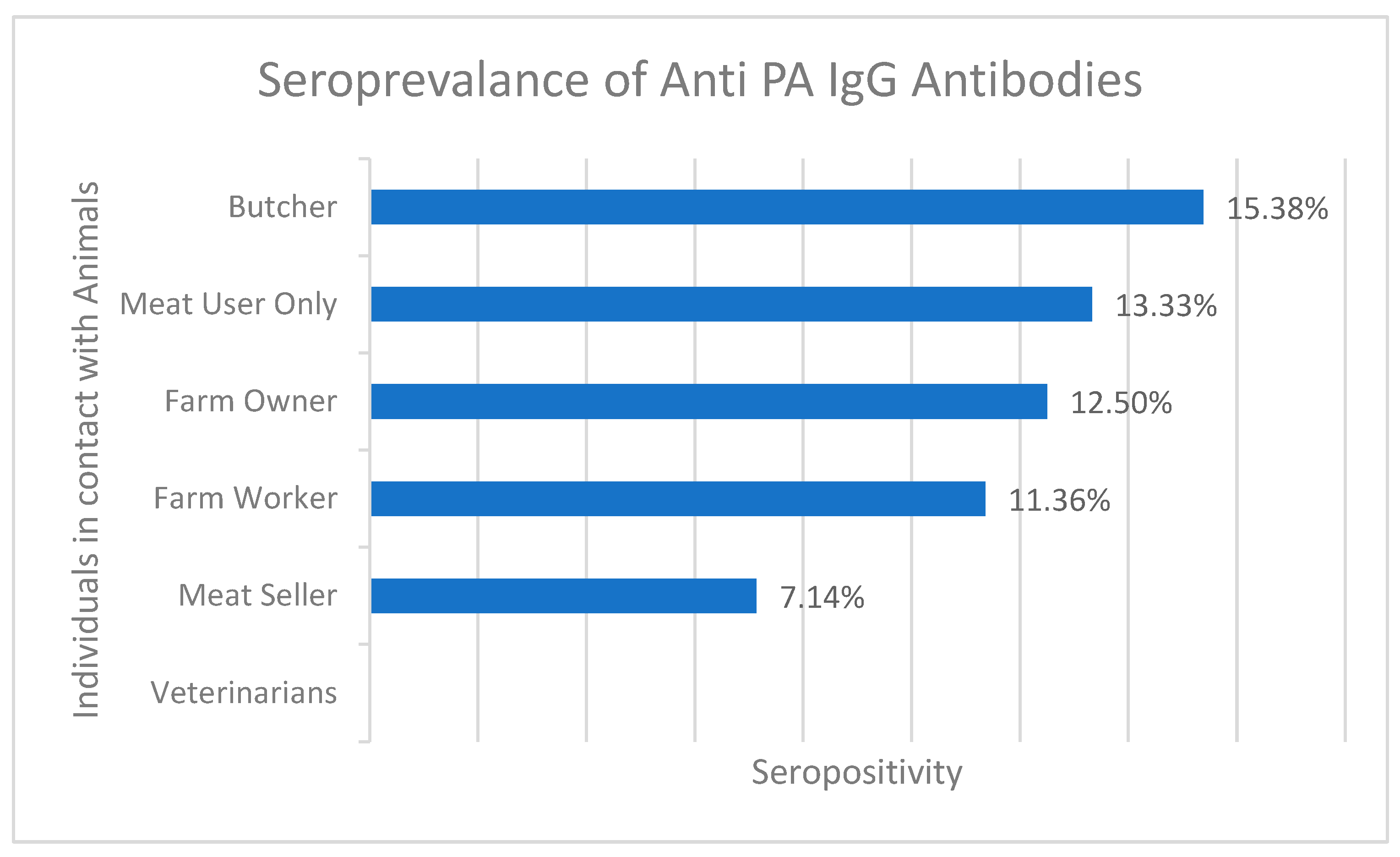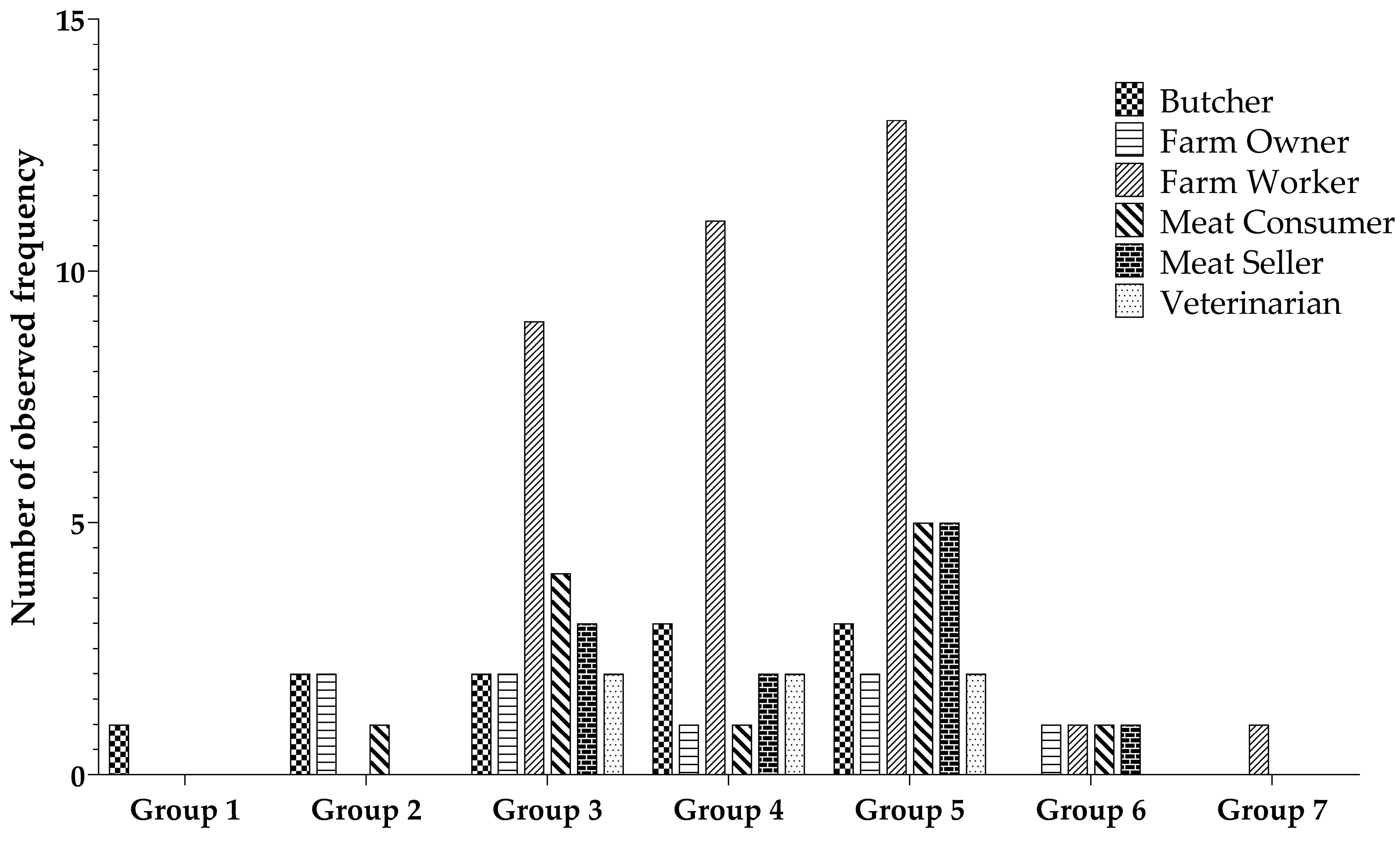One Health Assessment of Bacillus anthracis Incidence and Detection in Anthrax-Endemic Areas of Pakistan
Abstract
:1. Introduction
2. Methodology
2.1. Study Areas and Sampling Strategy
2.2. Case Definition and Inclusion Criteria for Study
2.3. Animal Swab/Blood Samples
2.4. Environmental Samples
2.5. Human Blood/Swab Samples
2.6. Sample Processing
2.6.1. Microbiological and Molecular Testing of Animal Swab Samples
2.6.2. Bacterial Genomic DNA Extraction and Polymerase Chain Reaction
2.6.3. Turner Method for Plant Root Samples Processing
2.6.4. GABRI Method for Soil Sample Processing
2.6.5. ELISA of Human Samples for Antibody Detection
2.6.6. ELISA of Human Samples for Anthrax Toxin Receptor 1 Quantification
2.6.7. Microscopic and Molecular Confirmation of Bacillus Anthracis in Human
2.6.8. Assessment of Personal Demographics and Contact with Anthrax Suspected Animals
2.6.9. Statistical Analysis
3. Results
3.1. Microbiological and Molecular Testing of Animal Swab Samples
3.2. Microscopic and Molecular Testing of Plant Root Samples
3.3. Microscopic and Molecular Testing of Soil Samples
3.4. Microscopic and Molecular Testing of Human Swab Samples
3.5. ELISA of Human Samples for IgG Antibody Detection
3.6. ELISA of Human Samples for Anthrax Toxin Receptor 1 Quantification
4. Discussion
Supplementary Materials
Author Contributions
Funding
Institutional Review Board Statement
Informed Consent Statement
Data Availability Statement
Conflicts of Interest
References
- Fasanella, A.; Serrecchia, L.; Chiaverini, A.; Garofolo, G.; Muuka, G.M.; Mwambazi, L. Use of Canonical Single Nucleotide Polymorphism (CanSNPs) to characterize Bacillus anthracis outbreak strains in Zambia between 1990 and 2014. PeerJ 2018, 6, e5270. [Google Scholar] [CrossRef] [PubMed]
- Hueffer, K.; Drown, D.; Romanovsky, V.; Hennessy, T. Factors contributing to anthrax outbreaks in the circumpolar north. EcoHealth 2020, 17, 174–180. [Google Scholar] [CrossRef] [PubMed]
- Navdarashvili, A.; Doker, T.; Geleishvili, M.; Haberling, D.; Kharod, G.; Rush, T.; Maes, E.; Zakhashvili, K.; Imnadze, P.; Bower, W. Human anthrax outbreak associated with livestock exposure: Georgia, 2012. Epidemiol. Infect. 2016, 144, 76–87. [Google Scholar] [CrossRef]
- Zasada, A.A. Injectional anthrax in human: A new face of the old disease. Adv. Clin. Exp. Med. 2018, 27, 553–558. [Google Scholar] [CrossRef] [PubMed]
- Berger, T.; Kassirer, M.; Aran, A. Injectional anthrax-new presentation of an old disease. Eurosurveillance 2014, 19, 20877. [Google Scholar] [CrossRef] [PubMed]
- Goel, A.K. Anthrax: A disease of biowarfare and public health importance. World J. Clin. Cases WJCC 2015, 3, 20. [Google Scholar] [CrossRef]
- Mwakapeje, E.R.; Høgset, S.; Fyumagwa, R.; Nonga, H.E.; Mdegela, R.H.; Skjerve, E. Anthrax outbreaks in the humans-livestock and wildlife interface areas of Northern Tanzania: A retrospective record review 2006–2016. BMC Public Health 2018, 18, 106. [Google Scholar] [CrossRef]
- Ngetich, W. Review of anthrax: A disease of animals and humans. Int. J. Agric. Env. Bioresearch 2019, 4, 1–11. [Google Scholar]
- Mwakapeje, E.R. Use of a One Health Approach for Understanding the Epidemiology and Management of Anthrax Outbreaks in the Human-Livestock-Wildlife and Environmental Health Interface Areas of Northern Tanzania; Norwegian University of Life Sciences: Ås, Norway, 2019. [Google Scholar]
- Timofeev, V.; Goncharova, Y.; Bahtejeva, I.; Titareva, G.; Kravchenko, T.; Dyatlov, I. Allelic Polymorphism of Anthrax Toxin Synthesis Genes: Phylogenetic and Phylogeographic Aspects. Preprints 2021, 2021080568. [Google Scholar]
- Carlson, C.J.; Kracalik, I.T.; Ross, N.; Alexander, K.A.; Hugh-Jones, M.E.; Fegan, M.; Elkin, B.T.; Epp, T.; Shury, T.K.; Zhang, W. The global distribution of Bacillus anthracis and associated anthrax risk to humans, livestock and wildlife. Nat. Microbiol. 2019, 4, 1337–1343. [Google Scholar] [CrossRef]
- Sardar, N.; Yaqub, T.; Anjum, A.; Javed, M.; Ayub, S.; Mukhtar, N.; Aslam, H.; Wolfe, A.J.; Schabacker, D.S.; Forrester, S.; et al. Endemic Seroprevalence and Farmer Control Measures of Anthrax Among Ruminate Animals in Pakistan. J. Anim. Plant Sci. 2023, 33. Available online: https://www.thejaps.org.pk/Volume/2023/33-04/19.php (accessed on 28 September 2023).
- Rajput, M.; Kamboh, A.A.; Dewani, P.; Umrani, A.P.; Abro, S.H.; Khan, M.A. Prevalence of Bacillus anthracis spores in wool, hairs and habitat of small ruminants. Indian J. Anim. Res. 2018, 52, 131–135. [Google Scholar] [CrossRef]
- Pinstrup-Andersen, P. The African Food System and Its Interaction with Human Health and Nutrition, 1st ed.; Cornell University Press: New York, NY, USA, 2010. [Google Scholar]
- Kahn, L.H. One Health and the Politics of Antimicrobial Resistance; JHU Press: Baltimore, MD, USA, 2016. [Google Scholar]
- Kock, R.; Haider, N.; Mboera, L.E.; Zumla, A. A One-Health lens for anthrax. Lancet Planet. Health 2019, 3, e285. [Google Scholar] [CrossRef] [PubMed]
- Pinzón-Arango, P.A. Investigation of the Biological and Physicochemical Properties of Bacillus anthracis Spores during Germination, Virulence, and Killing; Worcester Polytechnic Institute: Worcester, MA, USA, 2012. [Google Scholar]
- Finke, E.-J.; Beyer, W.; Loderstädt, U.; Frickmann, H. The risk of contracting anthrax from spore-contaminated soil–A military medical perspective. Eur. J. Microbiol. Immunol. 2020, 10, 29–63. [Google Scholar] [CrossRef] [PubMed]
- Carlson, C.J.; Getz, W.M.; Kausrud, K.L.; Cizauskas, C.A.; Blackburn, J.K.; Bustos Carrillo, F.A.; Colwell, R.; Easterday, W.R.; Ganz, H.H.; Kamath, P.L. Spores and soil from six sides: Interdisciplinarity and the environmental biology of anthrax (Bacillus anthracis). Biol. Rev. 2018, 93, 1813–1831. [Google Scholar] [CrossRef] [PubMed]
- Evard, M. Ecological Dynamics of Bacillus Anthracis in Water and Soils at Selected Sites in Etosha National Park, Namibia; University of Namibia: Windhoek, Namibia, 2021. [Google Scholar]
- Oppenheimer-Shaanan, Y.; Jakoby, G.; Starr, M.L.; Karliner, R.; Eilon, G.; Itkin, M.; Malitsky, S.; Klein, T. A dynamic rhizosphere interplay between tree roots and soil bacteria under drought stress. Elife 2022, 11, e79679. [Google Scholar] [CrossRef]
- Ekwem, D.; Morrison, T.A.; Reeve, R.; Enright, J.; Buza, J.; Shirima, G.; Mwajombe, J.K.; Lembo, T.; Hopcraft, J.G.C. Livestock Movement Informs the Risk of Disease Spread in Traditional Production Systems in East Africa. Sci. Rep. 2021, 11, 16375. [Google Scholar] [CrossRef]
- Fasanella, A.; Losito, S.; Adone, R.; Ciuchini, F.; Trotta, T.; Altamura, S.; Chiocco, D.; Ippolito, G. PCR assay to detect Bacillus anthracis spores in heat-treated specimens. J. Clin. Microbiol. 2003, 41, 896–899. [Google Scholar] [CrossRef]
- Turner, W.C.; Kausrud, K.L.; Beyer, W.; Easterday, W.R.; Barandongo, Z.R.; Blaschke, E.; Cloete, C.C.; Lazak, J.; Van Ert, M.N.; Ganz, H.H. Lethal exposure: An integrated approach to pathogen transmission via environmental reservoirs. Sci. Rep. 2016, 6, 27311. [Google Scholar] [CrossRef]
- Fasanella, A.; Di Taranto, P.; Garofolo, G.; Colao, V.; Marino, L.; Buonavoglia, D.; Pedarra, C.; Adone, R.; Hugh-Jones, M. Ground Anthrax Bacillus Refined Isolation (GABRI) method for analyzing environmental samples with low levels of Bacillus anthracis contamination. BMC Microbiol. 2013, 13, 167. [Google Scholar] [CrossRef]
- Apriliana, U.; Wibawa, H.; Ruhiat, E.; Untari, T.; Indarjulianto, S. Isolation and identification of avirulent strains of Bacillus anthracis from environmental samples in Central Java, Indonesia. Int. J. One Health 2021, 7, 204–211. [Google Scholar] [CrossRef]
- Luna, V.A.; Gulledge, J.; Cannons, A.C.; Amuso, P.T. Improvement of a selective media for the isolation of B. anthracis from soils. J. Microbiol. Methods 2009, 79, 301–306. [Google Scholar] [CrossRef] [PubMed]
- Uchida, I.; Sekizaki, T.; Hashimoto, K.; Terakado, N. Association of the Encapsulation of Bacillus Anthracis with a 60 Megadalton Plasmid. J. Gen. Microbiol. 1985, 131, 363–367. [Google Scholar] [CrossRef] [PubMed]
- Atawodi, J.; Dzikwi, A.; Odoba, M.; Dagai, D. Animals as reservoir of some human diseases. Electron. J. Biol. 2013, 9, 24–28. [Google Scholar]
- Ganz, H.H.; Turner, W.C.; Brodie, E.L.; Kusters, M.; Shi, Y.; Sibanda, H.; Torok, T.; Getz, W.M. Interactions between Bacillus anthracis and plants may promote anthrax transmission. PLoS Neglected Trop. Dis. 2014, 8, e2903. [Google Scholar] [CrossRef]
- Hugh-Jones, M.; Blackburn, J. The ecology of Bacillus anthracis. Mol. Asp. Med. 2009, 30, 356–367. [Google Scholar] [CrossRef]
- Dupke, S.; Schubert, G.; Beudjé, F.; Barduhn, A.; Pauly, M.; Couacy-Hymann, E.; Grunow, R.; Akoua-Koffi, C.; Leendertz, F.H.; Klee, S.R. Serological evidence for human exposure to Bacillus cereus biovar anthracis in the villages around Taï National Park, Côte d’Ivoire. PLoS Neglected Trop. Dis. 2020, 14, e0008292. [Google Scholar] [CrossRef]
- Mawak, J.; Fayam, A.; Lar, P.; Zakari, H.; Ngbede, J. Seroprevalence of Bacillus antracis in Jos and environs. Afr. J. Clin. Exp. Microbiol. 2006, 7, 195–198. [Google Scholar] [CrossRef]
- Ingram, R.J.; Harris, A.; Ascough, S.; Metan, G.; Doganay, M.; Ballie, L.; Williamson, E.D.; Dyson, H.; Robinson, J.H.; Sriskandan, S. Exposure to anthrax toxin alters human leucocyte expression of anthrax toxin receptor 1. Clin. Exp. Immunol. 2013, 173, 84–91. [Google Scholar] [CrossRef]
- Abrami, L.; Brandi, L.; Moayeri, M.; Brown, M.J.; Krantz, B.A.; Leppla, S.H.; van der Goot, F.G. Hijacking multivesicular bodies enables long-term and exosome-mediated long-distance action of anthrax toxin. Cell Rep. 2013, 5, 986–996. [Google Scholar] [CrossRef]
- Islam, M.S.; Hossain, M.J.; Mikolon, A.; Parveen, S.; Khan, M.S.U.; Haider, N.; Chakraborty, A.; Titu, A.M.N.; Rahman, M.W.; Sazzad, H.M. Risk practices for animal and human anthrax in Bangladesh: An exploratory study. Infect. Ecol. Epidemiol. 2013, 3, 21356. [Google Scholar] [CrossRef] [PubMed]
- Patil, R.R. Anthrax: Public health risk in India and socio-environmental determinants. Indian J. Community Med. Off. Publ. Indian Assoc. Prev. Soc. Med. 2010, 35, 189. [Google Scholar] [CrossRef] [PubMed]




| Outbreak No. | Date DD/MM/YY | Location | Animal | Brief Clinical History | Collected Samples | ||||
|---|---|---|---|---|---|---|---|---|---|
| Animal Blood/Swab | Soil | Plant Roots | Human Swabs | Human Blood | |||||
| 1 | 7 March 2019 | Zhob | Sheep | Sudden mortality, blood oozing out and bloating | 20 | 30 | 10 | 0 | 4 |
| 2 | 29 March 2019 | Zhob | Sheep | Sudden mortality | 20 | 30 | 10 | 0 | 4 |
| 3 | 21 April 2019 | Bajour | Goat | Sudden mortality | 20 | 30 | 10 | 0 | 15 |
| 4 | 8 June 2019 | Zhob | Goat | Sudden mortality, blood oozing out and blotches | 20 | 30 | 10 | 0 | 4 |
| 5 | 14 July 2019 | Bajour | Goat | Sudden mortality, blood oozing out and blotches | 20 | 30 | 10 | 3 | 15 |
| 6 | 5 August 2019 | Zhob | Goat | Sudden mortality | 20 | 30 | 10 | 0 | 4 |
| 7 | 12 October 2019 | Zhob | Sheep | Sudden mortality | 20 | 30 | 10 | 0 | 4 |
| 8 | 17 April 2019 | Bajour | Sheep | Sudden mortality, blood oozing out and blotches | 20 | 30 | 10 | 3 | 15 |
| 9 | 4 May 2020 | Bajour | Cattle | Sudden mortality, blood oozing out and blotches | 20 | 30 | 10 | 3 | 15 |
| 10 | 22 June 2020 | Zhob | Sheep | Sudden mortality | 20 | 30 | 10 | 0 | 4 |
| 11 | 13 July 2020 | Bajour | Sheep | Sudden mortality | 20 | 30 | 10 | 3 | 15 |
| 12 | 5 August 2020 | Zhob | Sheep | Sudden mortality, blood oozing out and blotches | 20 | 30 | 10 | 0 | 4 |
| 13 | 16 October 2020 | Zhob | Goat | Sudden mortality | 20 | 30 | 10 | 0 | 4 |
| 14 | 4 November 2020 | Zhob | Sheep | Sudden mortality, blood oozing out and blotches | 20 | 30 | 10 | 0 | 4 |
| 15 | 12 March 2021 | Bajour | Cattle | Sudden mortality, blood oozing out and blotches | 20 | 30 | 10 | 0 | 15 |
| 16 | 2 April 2021 | Zhob | Sheep | Sudden mortality | 20 | 30 | 10 | 0 | 4 |
| 17 | 18 June 2021 | Zhob | Sheep | Sudden mortality, blood oozing out and blotches | 20 | 30 | 10 | 0 | 4 |
| 18 | 23 June 2021 | Bajour | Cattle | Sudden mortality, blood oozing out and blotches | 20 | 30 | 10 | 3 | 15 |
| 19 | 19 July 2021 | Bajour | Sheep | Sudden mortality, blood oozing out and blotches | 20 | 30 | 10 | 3 | 15 |
| Microscopic and Growth Results | Molecular Confirmation | Conclusion | |||||||
|---|---|---|---|---|---|---|---|---|---|
| No. of Positive Samples | No. of Positive Samples | ||||||||
| Outbreak No. | Animal Blood/Swab Samples | Soil | Plant Roots | Human Swabs | Animal Blood/Swab Samples | Soil | Plant Roots | Human Swabs | |
| 1 | 4 | 9 | 2 | 0 | 4 | 3 | 0 | 0 | Positive |
| 2 | 3 | 13 | 0 | 0 | 0 | 0 | 0 | 0 | Negative |
| 3 | 6 | 7 | 0 | 0 | 0 | 0 | 0 | 0 | Negative |
| 4 | 2 | 6 | 3 | 0 | 3 | 5 | 2 | 0 | Positive |
| 5 | 4 | 9 | 0 | 2 | 4 | 6 | 3 | 2 | Positive |
| 6 | 4 | 12 | 1 | 0 | 0 | 0 | 0 | 0 | Negative |
| 7 | 3 | 5 | 2 | 0 | 0 | 0 | 0 | 0 | Negative |
| 8 | 6 | 11 | 0 | 3 | 2 | 2 | 0 | 2 | Positive |
| 9 | 4 | 10 | 4 | 1 | 4 | 8 | 2 | 3 | Positive |
| 10 | 2 | 13 | 2 | 0 | 4 | 9 | 1 | 0 | Positive |
| 11 | 2 | 4 | 3 | 2 | 7 | 10 | 3 | 0 | Positive |
| 12 | 3 | 8 | 0 | 0 | 3 | 6 | 2 | 0 | Positive |
| 13 | 4 | 6 | 6 | 0 | 0 | 0 | 0 | 0 | Negative |
| 14 | 3 | 9 | 4 | 0 | 0 | 0 | 0 | 0 | Negative |
| 15 | 2 | 12 | 5 | 0 | 0 | 0 | 0 | 0 | Negative |
| 16 | 3 | 5 | 4 | 0 | 3 | 3 | 2 | 0 | Positive |
| 17 | 4 | 6 | 6 | 0 | 4 | 7 | 1 | 0 | Positive |
| 18 | 2 | 10 | 0 | 3 | 6 | 6 | 3 | 2 | Positive |
| 19 | 5 | 7 | 0 | 0 | 0 | 0 | 0 | 0 | Negative |
| Total | 66 | 162 | 42 | 11 | 44 | 65 | 19 | 9 | |
Disclaimer/Publisher’s Note: The statements, opinions and data contained in all publications are solely those of the individual author(s) and contributor(s) and not of MDPI and/or the editor(s). MDPI and/or the editor(s) disclaim responsibility for any injury to people or property resulting from any ideas, methods, instructions or products referred to in the content. |
© 2023 by the authors. Licensee MDPI, Basel, Switzerland. This article is an open access article distributed under the terms and conditions of the Creative Commons Attribution (CC BY) license (https://creativecommons.org/licenses/by/4.0/).
Share and Cite
Sardar, N.; Aziz, M.W.; Mukhtar, N.; Yaqub, T.; Anjum, A.A.; Javed, M.; Ashraf, M.A.; Tanvir, R.; Wolfe, A.J.; Schabacker, D.S.; et al. One Health Assessment of Bacillus anthracis Incidence and Detection in Anthrax-Endemic Areas of Pakistan. Microorganisms 2023, 11, 2462. https://doi.org/10.3390/microorganisms11102462
Sardar N, Aziz MW, Mukhtar N, Yaqub T, Anjum AA, Javed M, Ashraf MA, Tanvir R, Wolfe AJ, Schabacker DS, et al. One Health Assessment of Bacillus anthracis Incidence and Detection in Anthrax-Endemic Areas of Pakistan. Microorganisms. 2023; 11(10):2462. https://doi.org/10.3390/microorganisms11102462
Chicago/Turabian StyleSardar, Nageen, Muhammad Waqar Aziz, Nadia Mukhtar, Tahir Yaqub, Aftab Ahmad Anjum, Maryam Javed, Muhammad Adnan Ashraf, Rabia Tanvir, Alan J. Wolfe, Daniel S. Schabacker, and et al. 2023. "One Health Assessment of Bacillus anthracis Incidence and Detection in Anthrax-Endemic Areas of Pakistan" Microorganisms 11, no. 10: 2462. https://doi.org/10.3390/microorganisms11102462
APA StyleSardar, N., Aziz, M. W., Mukhtar, N., Yaqub, T., Anjum, A. A., Javed, M., Ashraf, M. A., Tanvir, R., Wolfe, A. J., Schabacker, D. S., Forrester, S., Khemmani, M., Aqel, A. A., Warraich, M. A., & Shabbir, M. Z. (2023). One Health Assessment of Bacillus anthracis Incidence and Detection in Anthrax-Endemic Areas of Pakistan. Microorganisms, 11(10), 2462. https://doi.org/10.3390/microorganisms11102462









